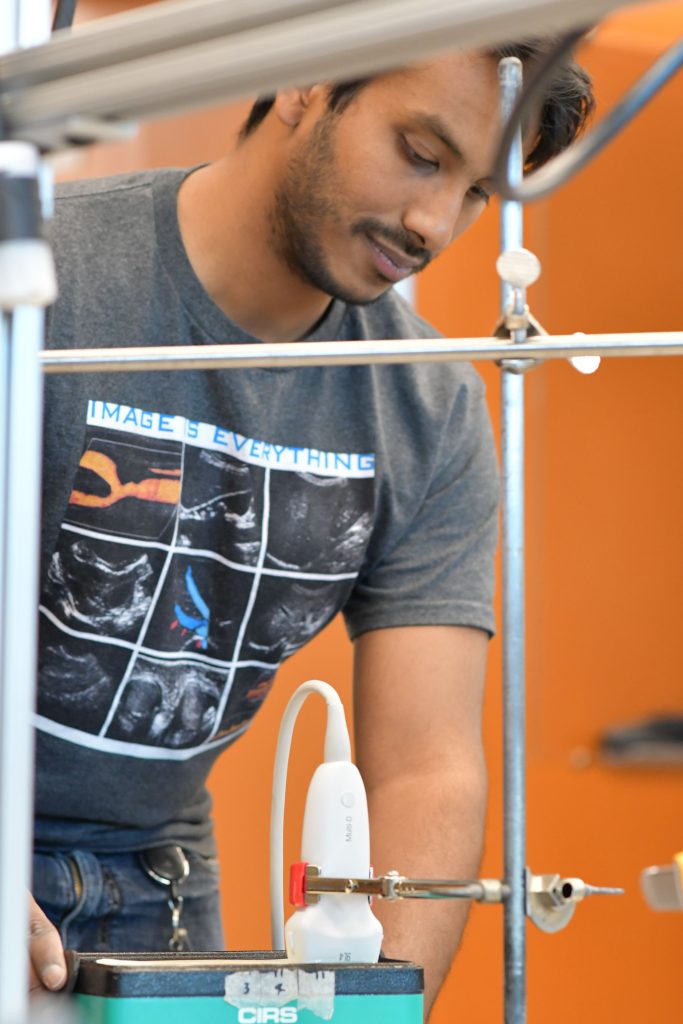A stroke can form for one of two reasons, according to the Centers for Disease Control and Prevention: when blood supply to your brain is blocked or when a blood vessel in the brain bursts. Rather than treating a patient in the aftermath of the medical episode, what if a proactive measure was taken? A measure that would help prevent strokes altogether?

Keerthi Anand (‘18) is a doctoral candidate in the UNC-NC State Joint Department of Biomedical Engineering where he approaches this issue through ultrasound imaging – research that positioned him to receive a 2023 Impact Award, generously supported by The Graduate School’s Graduate Education Advancement Board.
“I am enthusiastic about continuing to improve medical ultrasound technology to better predict stroke risk in North Carolinians,” Anand said. “I am honored to receive the Impact Award as it recognizes the contributions of my research in addressing the need for better healthcare outcomes in the state. ”
Anand’s interest in medical imaging began his sophomore year as an undergraduate at UNC-Chapel Hill where he majored in biomedical engineering. Initially unsure of which career path he’d pursue within the field, he found the intersection of programming and healthcare fascinating.
“I found that medical imaging was a great fit, where you incorporate a lot of computer science skills and apply them to detecting different diseases,” Anand said. ” His joint department has many researchers who specialize in medical ultrasound imaging, so after taking some classes with a very insightful professor, he settled on his academic path.
Following his graduation from Carolina, Anand immediately pursued graduate school, where he built on this interest through research. Caterina Gallippi, a professor in Anand’s department, had a project in the works Anand would bring to fruition: using high-framerate ultrasound imaging to better differentiate atherosclerotic plaques in your carotid arteries and measure the forces on the plaque from blood flow, before they cause strokes.
As we age, particles in our diet – such as cholesterol – gradually build on our arteries over time. As these particles grow larger and attract more cells, they develop into what’s called a plaque. Within the plaque, there is a tug-of-war of sorts between decaying cells and other particles trying to break free, and more protective cells, proteins, and calcium trying to keep everything contained. The plaque can either break off, block our arteries and bring on a stroke, or alternatively, remain safely attached to the artery it builds upon.
When patients come to clinics with symptoms of a stroke, ultrasound imaging is used to examine the plaque. However, typical imaging only allows clinicians to see grayscale images; images similar to pictures of a baby in the womb. In turn, identifying the plaque’s material and its likelihood of breaking off is more difficult to come by.
“My research comes in in using ultrasound to push on the plaque a very tiny amount. Similar to how you can tell how stiff a rubber band is by stretching it, you can tell what the plaque is made out of by pushing on it and seeing how much it moves and how it moves,” Anand explained. “So, if it doesn’t move that much, there’s something stiff inside of it; if it moves a lot, there’s something soft inside of it.” “We can also measure blood flow patterns around plaques using ultrasound and estimate the kind of forces that act on them.” These forces, called shear stresses, can sway a plaque either toward or away from causing a stroke.
Determining a plaque’s stiffness is done through use of acoustic ultrasound elastography. By focusing sound waves into the plaque and examining how the components move, clinicians are able to decide whether the plaque needs to be surgically removed. If its likelihood of breaking off is slim due to its durability or shear stresses, then a clinician has saved a patient from unnecessary surgery.
Anand has applied this same principle to a pandemic pastime: making TikToks that demonstrate physics behind sound and acoustic levitation, for which he won second place during a University-wide competition. He’s posted more than 120 videos to more than 8,000 followers, showing the power of sound – from making paper kites or cotton candy levitate to pink lemonade. He has used these levitators in hands-on demonstrations for science expos and classrooms across the state to inspire students to pursue STEM careers.
“Eventually when I find the time, I’d like to make more of these low-cost levitators that I designed to give out to students and inspire them to be more interested in ultrasound and STEM,” Anand said.
Following the completion of his doctoral degree, Anand hopes to pursue a career in industry in low-cost medical technology in order to increase healthcare accessibility.
By Kate Slate, The Graduate School
